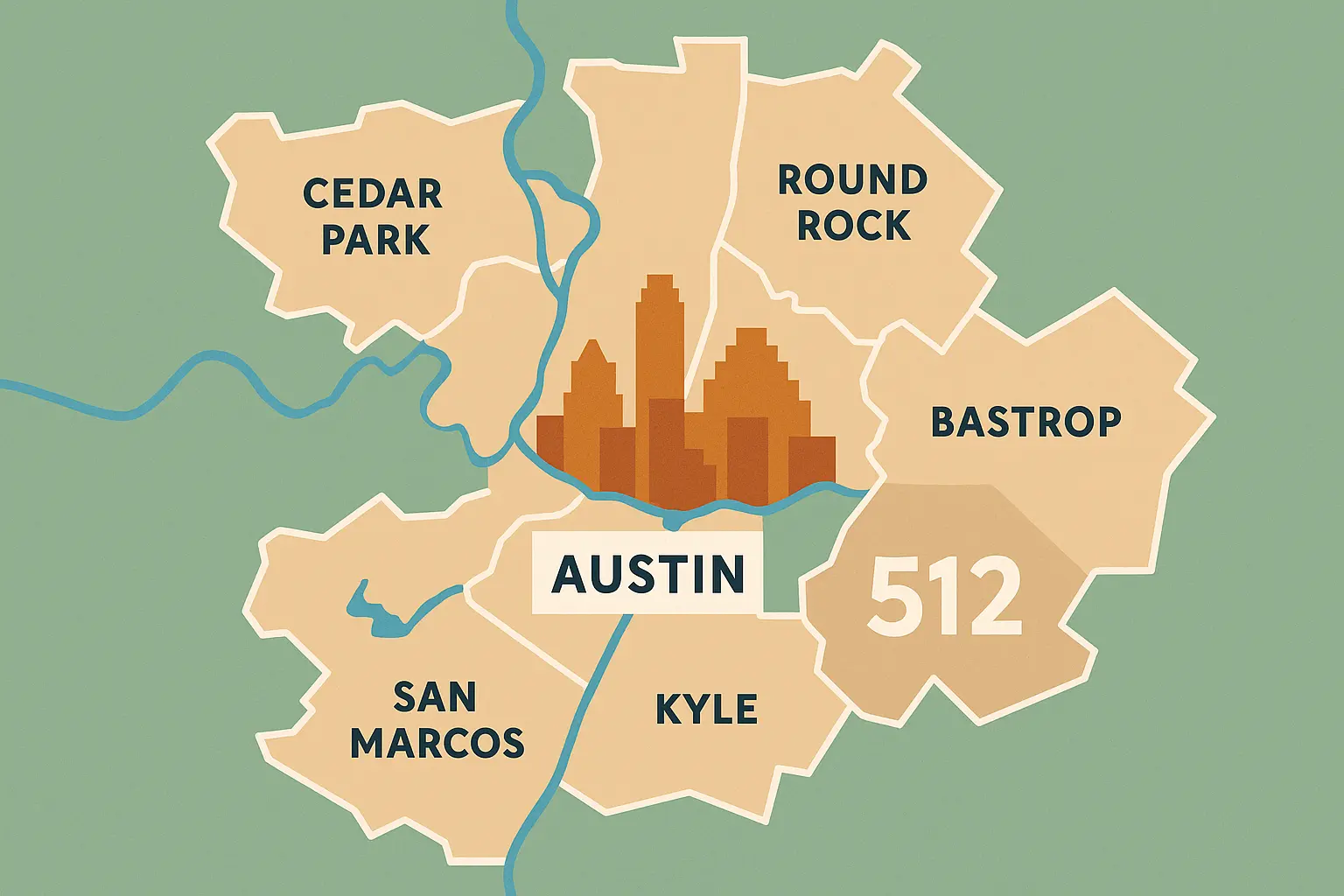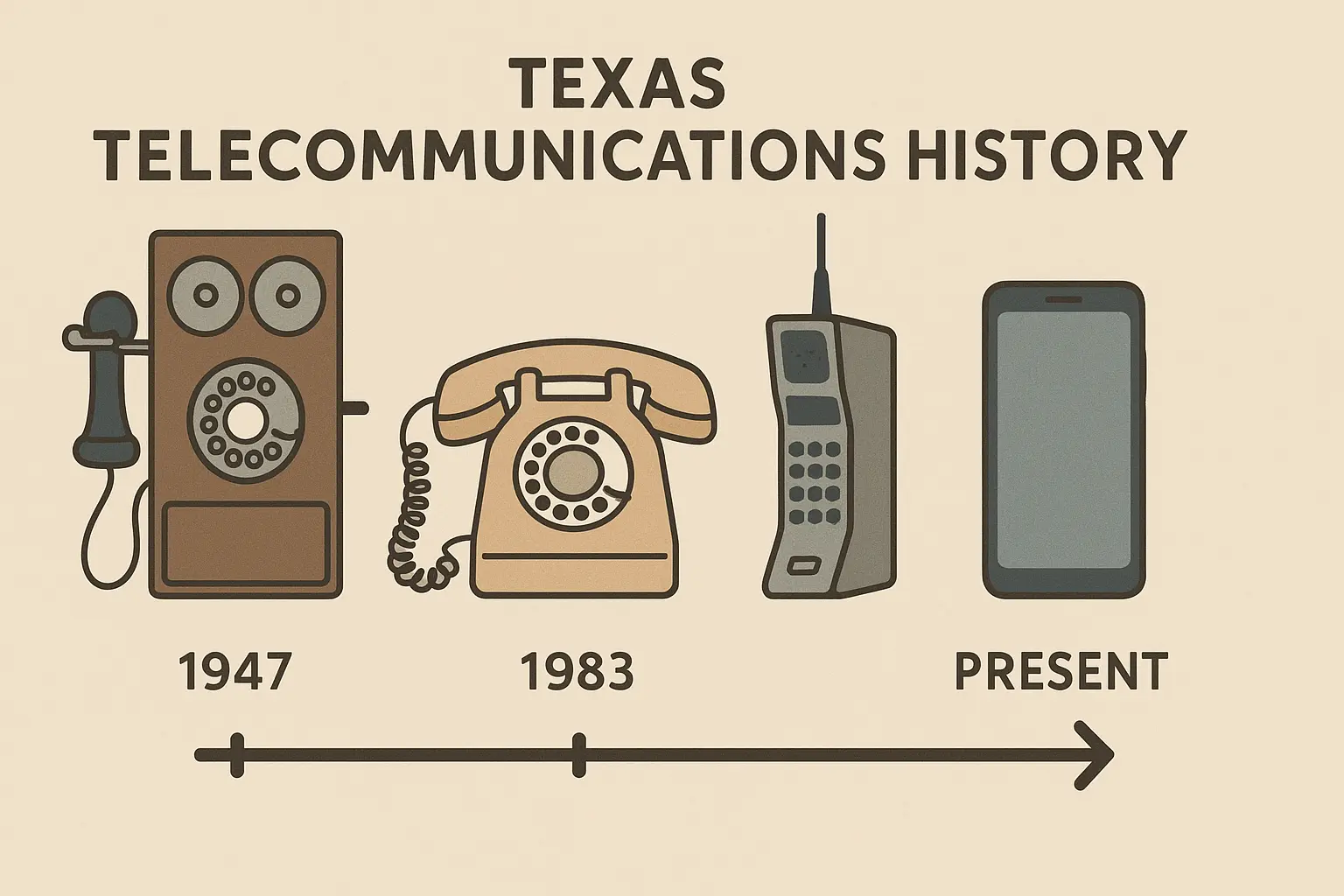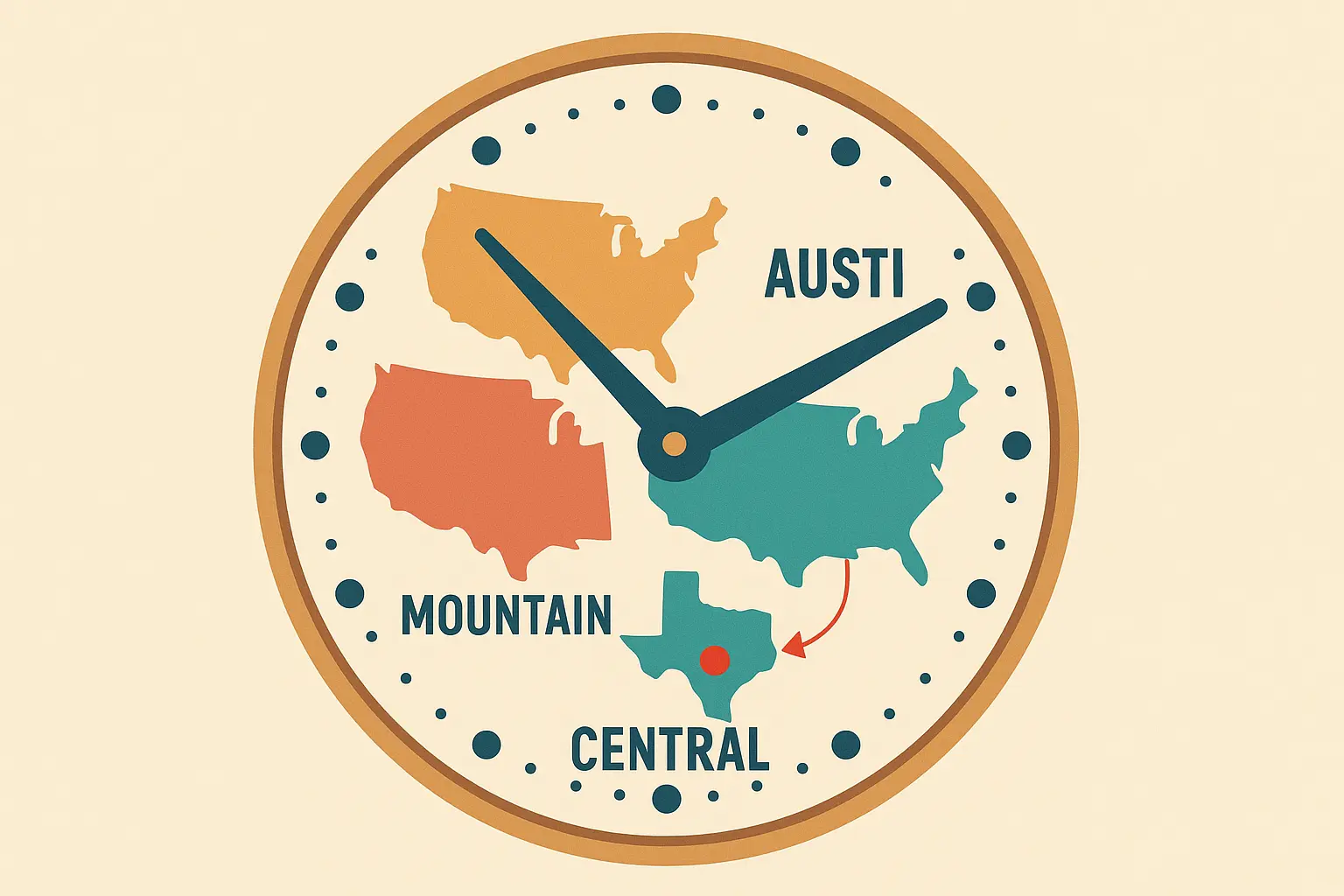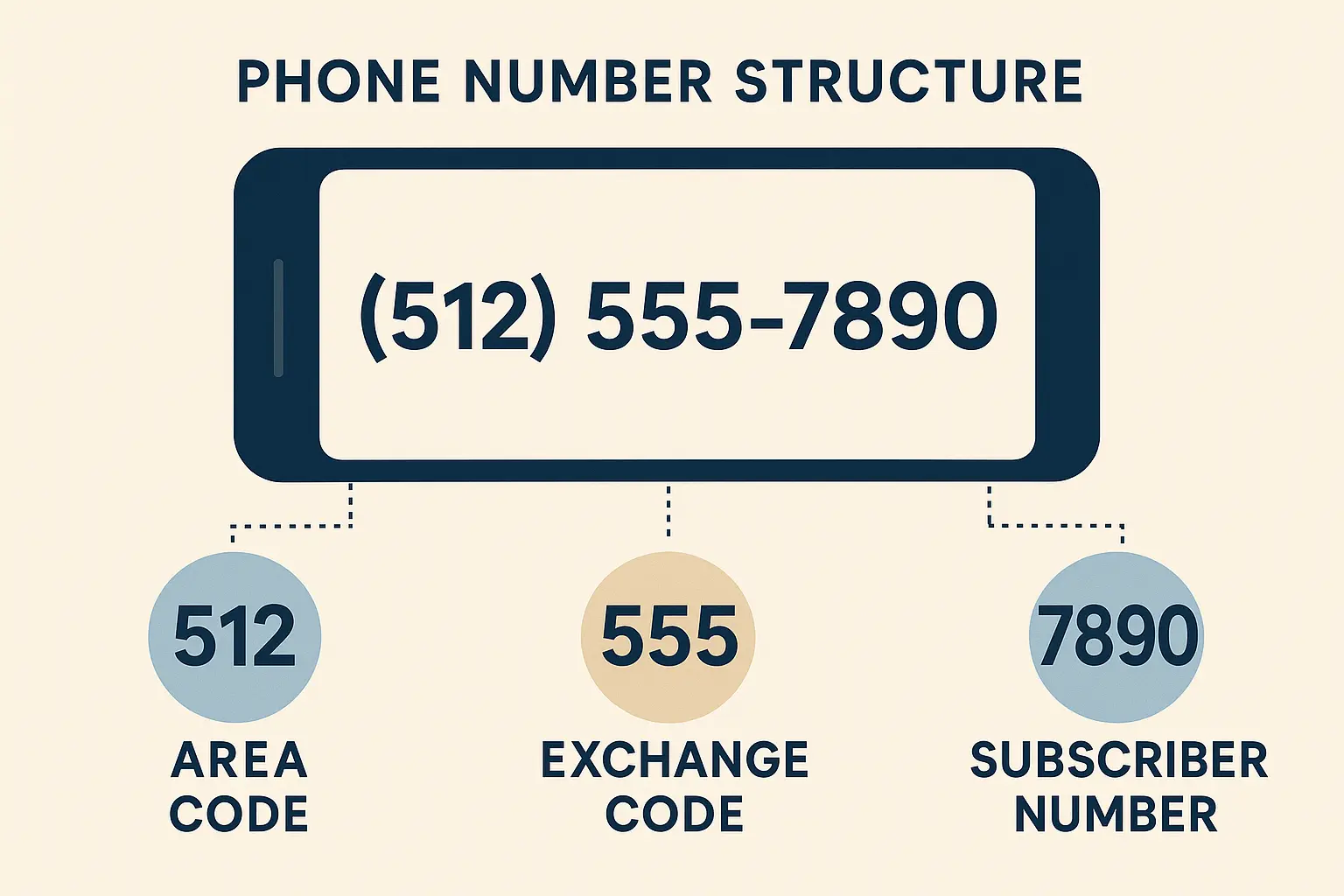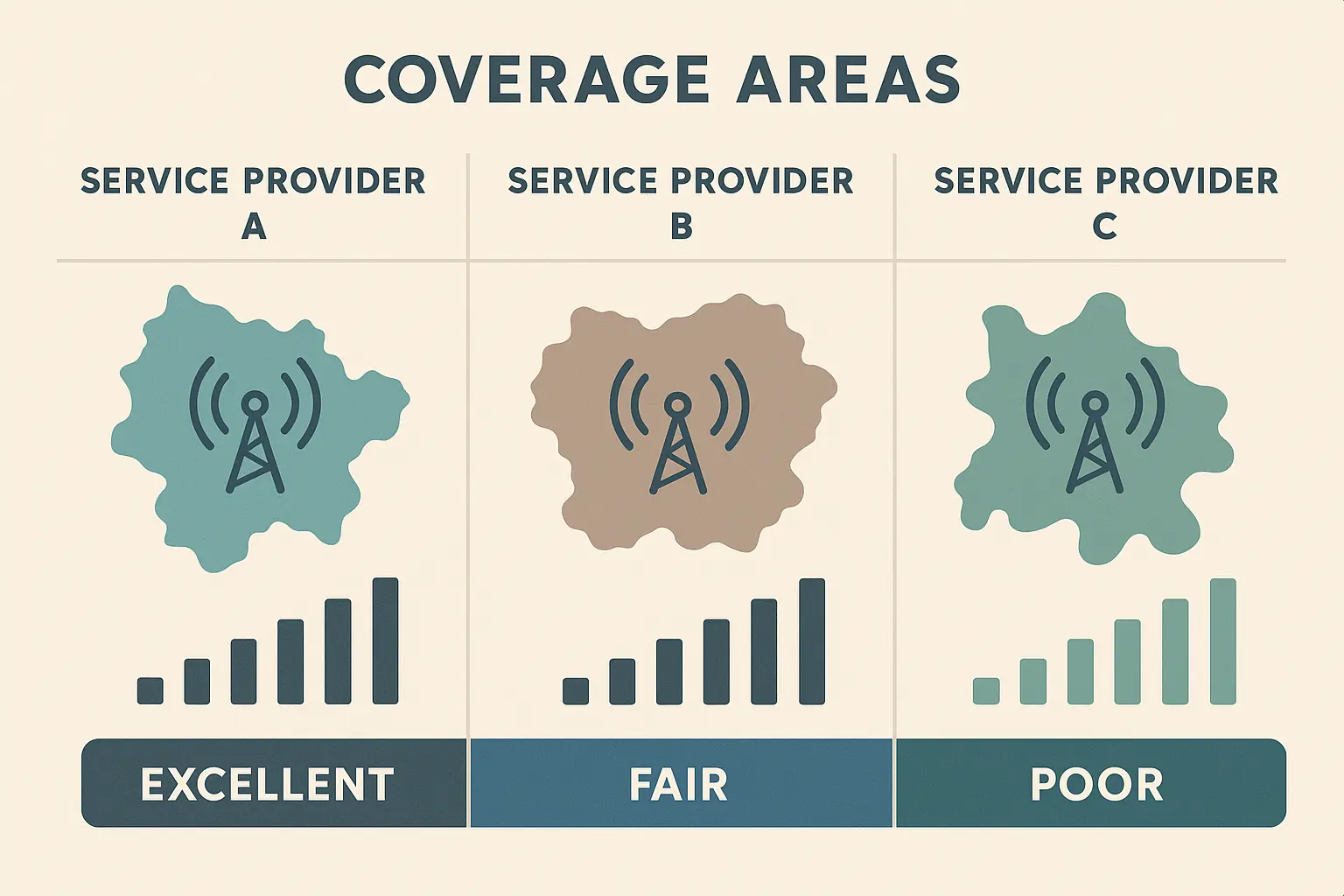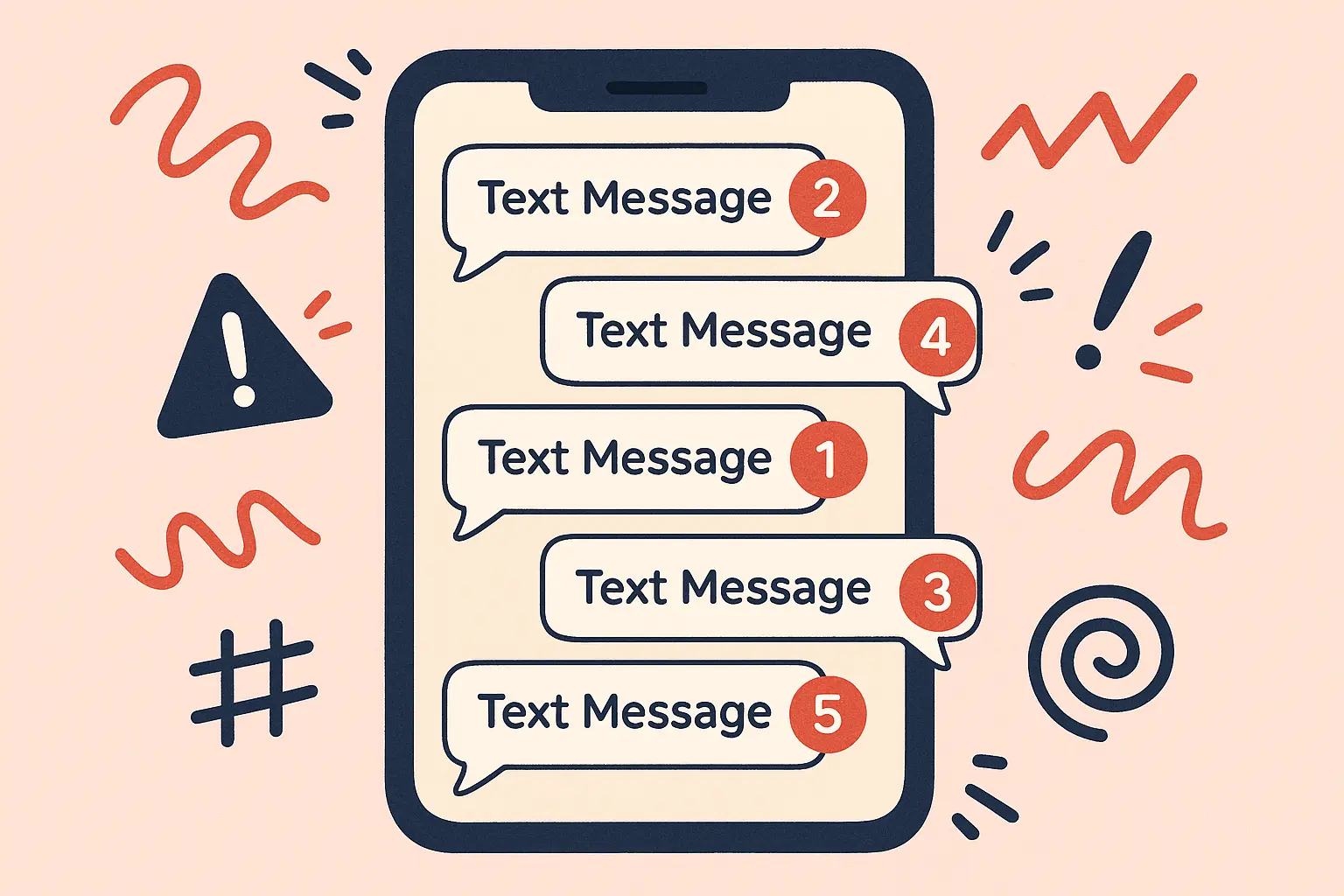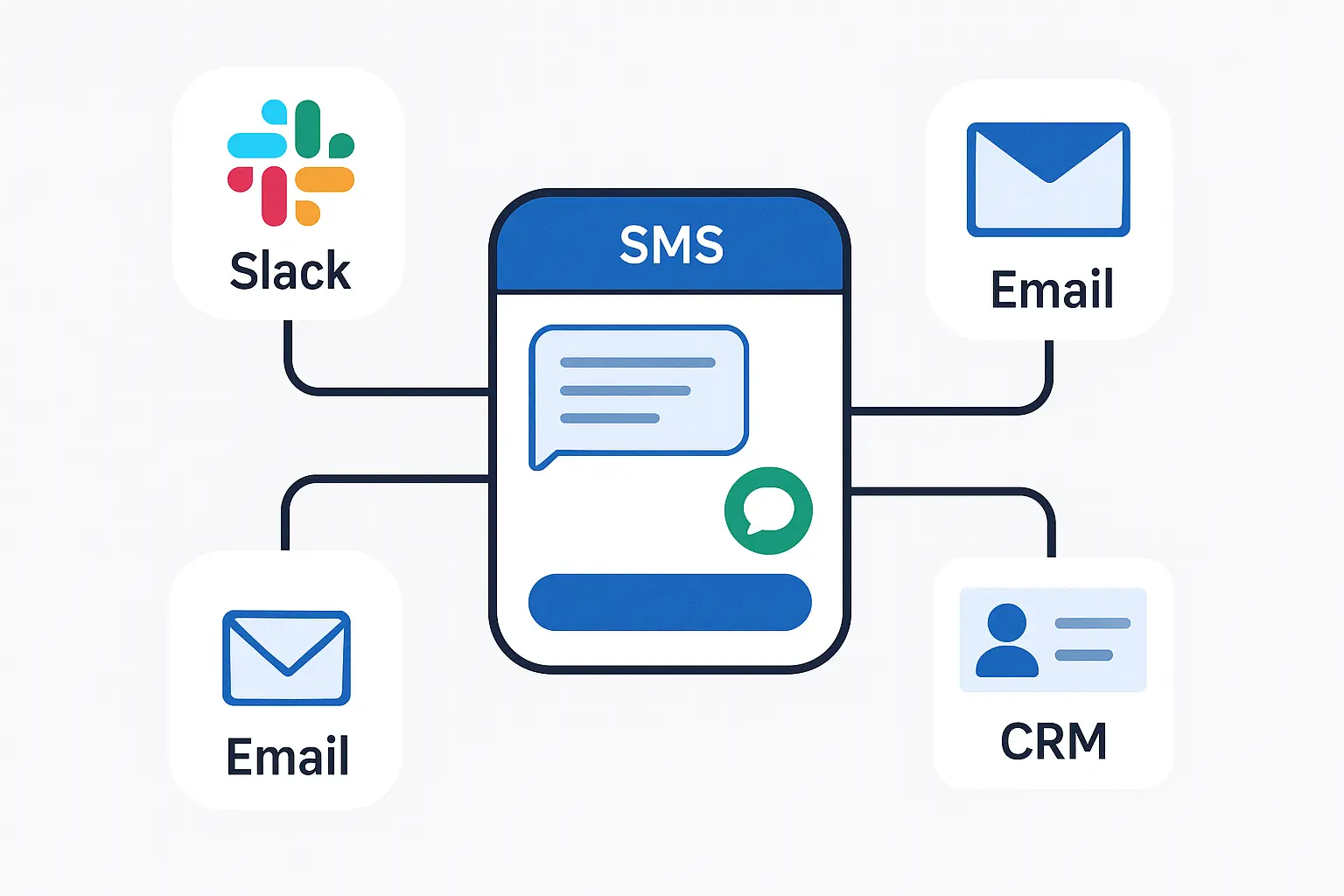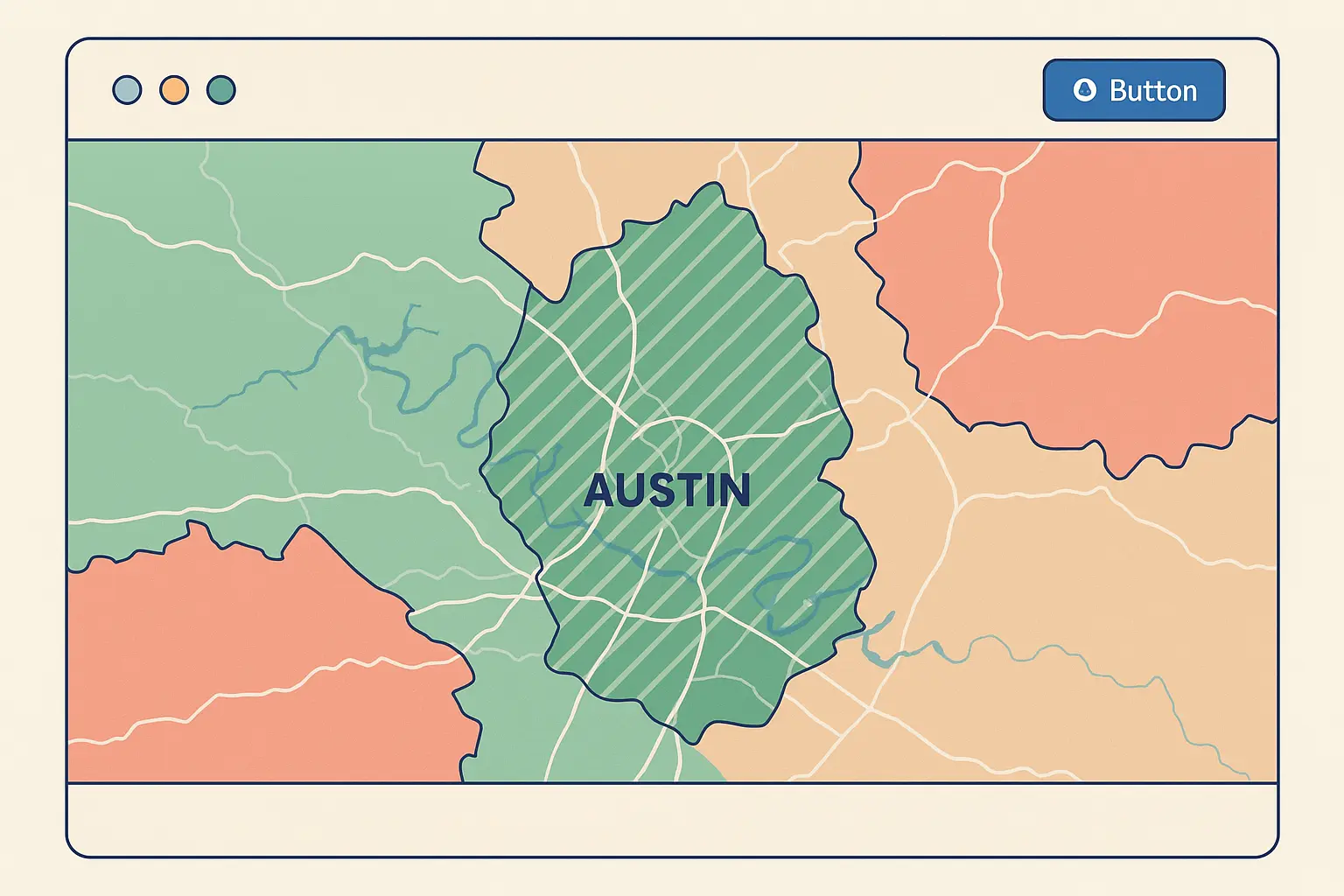I’ve called Austin home for years, and let me tell you – there’s way more drama around our 512 area code than you’d expect. Sure, everyone knows it’s “the Austin number,” but there’s a whole backstory here that affects everything from getting a local phone number to running a business in this crazy-growing city.
With over 2.3 million people using Austin’s area code, understanding these telecommunications secrets becomes crucial whether you’re a longtime Austinite or considering a move to the capital city. This knowledge will help you navigate local business culture, avoid communication pitfalls, and make the most of your Texas phone service experience.
According to recent population stats, the total population of Area Code 512 is 2,356,612 people, making it one of the most densely populated telecommunications regions in Texas. ZipAtlas Area Code 512 Demographics
Table of Contents
Table of Contents
-
Austin’s Geographic Territory and What It Really Covers
-
Time Zone Reality Check for Business Operations
-
Phone Number Structure That Actually Matters
-
Digital Communication Headaches You’ll Face
-
Visual Maps That Show the Real Boundaries
-
Final Thoughts
Austin’s Geographic Territory and What It Really Covers
Look, when people say they have an Austin number, they might actually be calling from Cedar Park or Round Rock – and that’s totally normal. The 512 coverage area is way bigger than just Austin proper, which catches a lot of newcomers off guard.
I remember when a friend moved here and got confused because her “Austin” number worked perfectly in Pflugerville, but her Uber driver kept asking if she was sure about her location. That’s the 512 reality – it stretches way beyond what you’d expect.
Understanding these boundaries matters whether you’re running a business, planning a move, or just trying to figure out if that local number is actually local. Austin’s area code encompasses more territory than newcomers expect, and the coverage extends well into surrounding counties.
The Real Coverage Story
When people say “Austin,” they usually mean different things depending on their perspective. Our area code covers the official boundaries plus several surrounding communities that many locals consider part of the greater Austin experience.
Here’s what actually gets the 512 treatment:
-
All of Austin (obviously)
-
Cedar Park and Round Rock (yeah, those count)
-
Pflugerville and parts of Georgetown
-
Even some areas down toward San Marcos
The weird part? Some of these places are 30 miles from downtown Austin, but they’re still rocking 512 numbers.
|
Community |
Coverage |
Distance from Downtown Austin |
Population Density |
|---|---|---|---|
|
Downtown Austin |
Full Coverage |
0 miles |
High |
|
South Austin |
Full Coverage |
3-8 miles |
High |
|
East Austin |
Full Coverage |
2-6 miles |
Medium-High |
|
Cedar Park |
Full Coverage |
18 miles |
Medium |
|
Round Rock |
Full Coverage |
20 miles |
Medium |
|
Pflugerville |
Full Coverage |
16 miles |
Medium |
|
Georgetown |
Partial Coverage |
26 miles |
Low-Medium |
|
San Marcos |
Partial Coverage |
30 miles |
Low-Medium |
Downtown and Core Neighborhoods
The heart of Austin – downtown, South Austin, East Austin, and West Austin – all operate under our area code. These core districts represent the cultural and business center of the city, where having a 512 number carries the most local credibility and recognition among residents and businesses.
A local Austin restaurant owner told me that customers are 40% more likely to call back when they see a 512 number on their caller ID versus a 737 number. This preference stems from the psychological association locals have with 512 being the “authentic” Austin area code, even though both serve identical geographic areas.
Suburban Communities You Didn’t Know Were Included
Cedar Park, Round Rock, Pflugerville, and other Travis County communities also use our area code, extending the coverage well beyond Austin proper. This broader coverage affects everything from local business marketing to understanding whether you’re making a “local” call.
The median household income in Area Code 512 is $94,281, significantly higher than the national average, which makes it an attractive market for businesses targeting affluent suburban communities within the extended Austin metro area. ZipAtlas Income Demographics
Many newcomers assume these suburban areas use different area codes, but they’re wrong. Your 512 number works seamlessly across this entire extended metro region, which explains why some “Austin” businesses are actually located 20+ miles from downtown.
How We Got Here
Our area code carries serious historical weight in Texas telecommunications. Originally established in 1947, it once covered a massive portion of central and south Texas before population growth forced multiple splits and overlays.
Back in 1947, the 512 area code was massive – it covered everything from San Antonio to College Station. Can you imagine? One area code for half of Texas. But as Austin exploded (thanks, tech boom), they had to keep shrinking our territory.
The Original 1947 Coverage That Stretched Across Texas
Back in 1947, our area code covered an enormous chunk of Texas, extending far beyond what we now consider the Austin area. This original coverage included multiple major cities and rural areas, making it one of the most geographically diverse area codes in the early North American Numbering Plan.
The original designation served communities from San Antonio to College Station, encompassing a territory that would require multiple area codes today.
Why the 737 Overlay Changed Everything
Then in 2012, they dropped the 737 overlay on us because we literally ran out of 512 numbers. Now when you get a new line, it’s basically a coin flip whether you’ll get the “real” Austin number or the newcomer digits.
The introduction of the 737 overlay became necessary because “the 512 area code, which has about 8 million phone numbers on record, will be exhausted by the end of the year” according to KUT News reporting on the telecommunications capacity crisis that hit Austin in 2012.
Current Boundaries vs. Historical Coverage
Today’s boundaries are precisely defined around the Austin metropolitan area, a dramatic reduction from the original statewide coverage. These current boundaries reflect Austin’s emergence as a major metropolitan center deserving its own dedicated telecommunications region.
The territory now focuses exclusively on the greater Austin area, a far cry from its original massive Texas footprint.
Time Zone Reality Check for Business Operations
Being smack in the middle of Central Time sounds convenient until you’re trying to coordinate with clients on both coasts. I’ve watched so many Austin businesses struggle with this.
Operating in the Central Time Zone affects every aspect of how Austin area communications work, from business hours to customer service expectations. The time zone placement creates specific scheduling challenges and opportunities that smart businesses learn to navigate effectively.
For businesses managing multiple area codes across different regions, understanding how to forward text messages to an email address becomes essential when coordinating communications across time zones with your Austin numbers.
Central Time Zone Impact on Daily Communications
Our area code operates in Central Time, which creates specific advantages and challenges for business communications. Your East Coast clients expect you to be available by 10 AM their time (that’s 9 AM for us), while your West Coast partners want to schedule calls at 4 PM their time (6 PM here).
One tech startup I know solved this by splitting their customer service team into early birds and night owls.
Standard Time Operations and Business Hours
During Central Standard Time (UTC-6), businesses with Austin numbers typically operate on schedules that align with other Central Time markets. This timing affects everything from customer service availability to when automated systems send messages or process transactions.
Business Hours Optimization for Austin Area Code:
-
Set core business hours between 9 AM – 5 PM Central Time
-
Account for 1-hour difference with East Coast clients (they’re ahead)
-
Plan for 2-hour difference with West Coast partners (they’re behind)
-
Schedule important calls between 11 AM – 3 PM Central for maximum overlap
-
Set automated systems to send messages during Central Time business hours
-
Train staff on time zone conversion for multi-region scheduling
Austin number holders need to be particularly careful about automated message timing to avoid annoying customers in other time zones.
Daylight Saving Time Shifts That Affect Scheduling
The time change twice a year? Pure chaos. Everyone’s confused for at least a week about when to schedule calls. The transition to Central Daylight Time (UTC-5) during summer months impacts scheduling with clients in other time zones.
Austin area businesses report the most scheduling confusion during the weeks immediately following time changes.
Cross-Time Zone Business Coordination Challenges
Companies using Austin area codes often work with clients and partners across multiple time zones, creating coordination challenges that require careful planning. The Central Time placement offers some advantages but also creates specific scheduling conflicts that businesses need to anticipate and manage.
Austin numbers put you right in the middle of the continental US time zone spread, which can be both blessing and curse.
Managing East and West Coast Client Expectations
Austin’s Central Time position means East Coast clients expect earlier responses while West Coast partners often schedule late-day calls. Businesses with Austin numbers need strategies for managing these competing time zone expectations without burning out their teams.
A tech startup in Austin with a main number discovered that their East Coast clients expected responses by 10 AM Central Time (11 AM Eastern), while their West Coast investors preferred 4 PM Central calls (2 PM Pacific). They solved this by implementing split-shift customer service coverage and automated email responses that clearly stated Central Time business hours.
Austin businesses that master time zone management gain a significant competitive advantage in national markets.
Phone Number Structure That Actually Matters
The technical structure of Austin area phone numbers follows standard North American formatting, but there are specific details about exchange codes, number availability, and service distinctions that affect how you use these numbers effectively in today’s telecommunications environment.
When setting up your Austin business number for maximum compatibility, it’s crucial to understand US phone number format with country code requirements for international business communications.
Understanding the (512) XXX-XXXX Format
Every Austin number follows the standard North American format, but the exchange codes (the first three digits after 512) can tell you specific information about geographic areas or service providers. Understanding this structure helps you make informed decisions about number selection and service planning.
Exchange codes carry historical significance that many businesses overlook when selecting numbers. The prefix connects to a rich telecommunications heritage that spans decades of Austin’s growth.
Exchange Code Variations Across Austin Areas
Different exchange codes within our area code often correspond to specific geographic regions or historical service provider territories within the Austin metro area. While this doesn’t affect call routing, it can influence local recognition and business credibility.
Numbers with certain exchange codes carry more local prestige than others, though this distinction matters more to longtime residents than newcomers.
|
Exchange Code Range |
Geographic Association |
Historical Provider |
Business Recognition |
|---|---|---|---|
|
512-2XX-XXXX |
Downtown Austin |
Southwestern Bell |
High |
|
512-3XX-XXXX |
South Austin |
GTE |
High |
|
512-4XX-XXXX |
East Austin |
Southwestern Bell |
Medium-High |
|
512-5XX-XXXX |
West Austin |
GTE |
High |
|
512-6XX-XXXX |
North Austin/Cedar Park |
Various |
Medium |
|
512-7XX-XXXX |
Round Rock Area |
Various |
Medium |
|
512-8XX-XXXX |
Pflugerville/Georgetown |
Various |
Medium |
|
512-9XX-XXXX |
Mixed Suburban |
Various |
Low-Medium |
Mobile vs. Landline Number Distinctions
Unlike international systems, Austin area numbers don’t indicate whether they’re mobile or landline services based on the number structure alone. This creates both flexibility and confusion when trying to determine the best way to contact someone with an Austin number.
Mobile and landline numbers are indistinguishable from the digits alone, which affects how people approach initial contact attempts.
Getting Your Hands on a 512 Number
Here’s the thing nobody tells you: getting a 512 number isn’t guaranteed anymore. New customers often get stuck with 737, and while it works exactly the same, it just doesn’t have that Austin street cred.
Number availability and assignment involves complex regulations and capacity management due to Austin’s rapid growth. The introduction of the 737 overlay has changed how new numbers are assigned, while number portability rules affect how you can move between service providers.
Number scarcity has created a secondary market where established numbers carry premium value for businesses seeking local credibility.
Number Portability Rules That Protect Your Investment
If you already have a 512, hold onto it. You can take it with you when you switch providers (number portability rules protect you), but finding a new one? Good luck with that lottery.
Local number portability regulations allow you to keep your Austin area number when switching service providers within the same geographic area. This protection is crucial for businesses that have built brand recognition around their specific number.
Austin Number Portability Requirements:
-
Verify current provider supports outbound porting
-
Confirm new provider accepts area code transfers
-
Gather account information and PIN from current provider
-
Schedule port during business hours to minimize downtime
-
Test all services after successful port completion
-
Update business listings with confirmed number retention
Number portability has become increasingly important as businesses recognize the local branding value of these digits.
Why New Customers Might Get 737 Instead
The 737 overlay means new customers in Austin might receive either a 512 or 737 area code depending on availability. While both serve the same area, many locals still prefer Austin’s original numbers for their perceived authenticity and established recognition.
The need for the 737 overlay was driven by “explosive growth in cell phone lines” according to the Public Utility Commission of Texas, as reported by KUT News, with the massive increase in mobile devices far outpacing the reduction in residential landlines.
Availability continues to shrink as Austin’s population grows, making existing numbers more valuable over time.
Business Advantages of Securing a 512 Number
Some businesses pay premium prices just to get a 512 number because of the local recognition factor. Is it worth it? Depends on how much you care about looking like an Austin native versus a transplant.
Local Austin businesses often prioritize getting these numbers because of their established recognition among area customers. This preference creates a competitive advantage for companies that secure these numbers, especially in customer-facing industries.
Austin’s original numbers signal local establishment and community connection in ways that newer area codes simply cannot match.
Digital Communication Headaches You’ll Face
This is where things get really frustrating. Your Austin number handles calls just fine, but text messages? That’s a whole different nightmare.
Modern communication extends far beyond voice calls, and Austin area numbers need to integrate with text messaging, digital platforms, and automated systems. I’ve experienced firsthand how challenging it can be to manage all the different ways people try to reach you through a single phone number.
Text Message Management Nightmares
Text messaging with Austin area numbers creates unique challenges, especially for businesses that need to track, forward, or archive communications across multiple channels. The complexity increases when you consider after-hours messages, team collaboration needs, and compliance requirements.
Many Austin businesses struggle with managing SMS communications on their numbers, which is why learning how to forward text messages on an Android phone becomes essential for comprehensive message management.
Text messaging creates operational bottlenecks that traditional phone systems weren’t designed to handle.
After-Hours Business Communication Problems
I know a law firm that was losing clients because urgent texts sent after 5 PM weren’t seen until morning. Important stuff was just sitting there while potential clients found other lawyers. They finally set up Auto Forward SMS to route those messages to whoever was on call, and their after-hours conversions jumped 60%.
With 67.3% of people in the labor force in Area Code 512, businesses face constant pressure to maintain responsive communication channels, as the high employment rate means customers expect quick responses even outside traditional business hours. ZipAtlas Labor Force Statistics
Austin businesses lose potential revenue when urgent after-hours texts go unnoticed until morning.
Why Businesses Struggle
The problem is that regular SMS doesn’t play nice with modern business tools. You get a text on your Austin number, but how do you share it with your team? How do you make sure nothing urgent gets missed on weekends?
Most businesses I know are still manually forwarding important texts or – even worse – just hoping nothing critical comes in after hours. It’s 2024, and we’re still playing phone tag with text messages.
For teams that need instant notification of Austin number messages, setting up text message forwarding to a Slack channel can dramatically improve response times and team coordination.
Message distribution challenges multiply as teams grow and communication needs become more complex.
Compliance and Record Keeping Requirements
Businesses operating with Austin area numbers may need to maintain records of text message communications for regulatory compliance. Manual record-keeping is time-consuming and error-prone, while automated solutions require technical integration that many small businesses can’t manage.
SMS Compliance Management for Austin Businesses:
-
Identify industry-specific text message retention requirements
-
Implement automated message archiving system
-
Train staff on proper SMS communication protocols
-
Set up secure backup storage for message records
-
Establish opt-in/opt-out procedures for marketing texts
-
Create audit trail documentation for compliance reviews
-
Review and update SMS policies quarterly
Compliance requirements vary by industry but affect nearly every business using text communications.
The Integration Problem
Your Austin number needs to work with Slack, your CRM, your email – basically everything except the basic SMS app on your phone. But getting all that connected? Most small businesses don’t have the tech expertise to make it happen.
Effective use of Austin area numbers in today’s business environment requires integration with digital tools, APIs, and automated systems that can handle multi-channel communications. The gap between traditional SMS and modern workflow tools creates operational inefficiencies that smart businesses need to address.
Advanced Austin businesses are discovering how forwarding text messages to an API URL endpoint allows their Austin numbers to integrate seamlessly with custom business applications and CRM systems.
Digital integration separates forward-thinking companies from those stuck in outdated communication patterns.
API and Webhook Integration Possibilities
Advanced communication setups allow Austin area text messages to be automatically forwarded to platforms like Slack, Microsoft Teams, or custom web APIs. This integration enables seamless workflow management but requires technical expertise that many businesses lack.
API integration opens possibilities for automated customer service, lead qualification, and real-time notification systems that transform how Austin businesses operate.
Visual Maps That Show the Real Boundaries
Want to know if a specific address gets 512 coverage? Don’t just guess based on the city name – I’ve seen Round Rock addresses with 512 numbers and some Austin addresses that don’t qualify.
Understanding exactly where our area code applies requires visual resources that show precise boundaries, coverage overlaps, and service provider territories. I’ve found that many people have misconceptions about coverage until they see the actual maps.
Digital Mapping Tools for Coverage
The interactive maps from the phone companies show you exactly where the boundaries are, including all the weird little pockets and exceptions. It’s worth checking before you assume anything about coverage.
Various online tools and resources provide visual representations of Austin area code boundaries, helping businesses and residents understand service territories and plan telecommunications strategies. These mapping resources reveal details that aren’t obvious from written descriptions alone.
Mapping tools have become essential for businesses planning expansion or trying to understand their local market reach.
Interactive Coverage Area Maps
Interactive maps show the precise boundaries of Austin area code coverage, including how it overlaps with the 737 overlay area and connects to neighboring area codes. These visual tools help you understand whether specific addresses fall within our territory.
Area Code Boundary Verification:
-
Use official NANPA (North American Numbering Plan Administration) maps
-
Cross-reference with local telecommunications provider coverage maps
-
Verify specific address coverage using carrier lookup tools
-
Check for recent boundary changes or updates
-
Confirm overlay area code (737) coverage matches boundaries
-
Document coverage verification for business planning purposes
Boundary verification prevents costly mistakes when planning service territories or marketing campaigns.
Service Provider Territory Comparisons
Different telecommunications providers may have varying coverage quality within the Austin area code region. Mapping resources help users compare service options and choose optimal providers for their specific location within the Austin metro area.
Service quality can vary significantly even within the same neighborhood, making provider comparison maps invaluable for business planning.
Final Thoughts
Your Austin number is more than just digits – it’s your connection to Austin’s identity and growth story. But making it work in today’s digital world requires more than just having the right area code.
Our area code represents more than just a set of digits – it’s a connection to Austin’s telecommunications history and a practical tool for modern communication needs. From its origins as a massive Texas territory to today’s focused Austin metro coverage, understanding these numbers helps you make better decisions about business communications and personal connectivity.
Whether you’re running a business or just trying to stay connected, the key is understanding that modern communication goes way beyond voice calls. Text messages, team coordination, after-hours coverage – all of that matters just as much as having those coveted digits.
Managing communications effectively with an Austin number requires more than just understanding the basics. Text message forwarding, team collaboration, and digital integration challenges are real problems that affect daily operations. That’s where Auto Forward SMS becomes invaluable for Austin-area businesses and individuals who can’t afford to miss important messages.
If you’re serious about making your Austin communications work seamlessly, Auto Forward SMS solves the biggest pain point: making sure you never miss important messages on your number, no matter when they come in or where you need them to go.
Whether you’re establishing a new business presence in Austin or optimizing existing communications, Auto Forward SMS ensures your Austin number works seamlessly with modern digital workflows. Ready to eliminate the frustration of missed text messages? Try Auto Forward SMS today and experience reliable message forwarding that keeps your Austin communications running smoothly.
Austin numbers will continue evolving as our city grows, but the fundamental need for reliable, integrated communication solutions remains constant across all technological changes.

